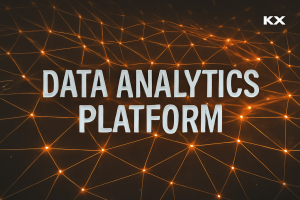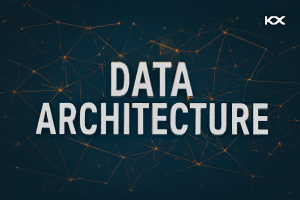Key Takeaways
- A data mart is a subject-specific data layer that supports reporting and decision-making for a defined business function
- It contains curated, structured data that is optimized for speed and ease of use
- Data marts help reduce query load on enterprise systems and provide teams with faster access to relevant insights
- They are widely used in capital markets to support trading, surveillance, compliance, and operations workflows
- Data marts can be dependent, independent, or hybrid, depending on how they connect to upstream systems
A data mart is a focused data repository that supports the needs of a specific department or function. Unlike enterprise data warehouses, which store organization-wide information, data marts provide a filtered and structured view tailored to a particular use case. This helps reduce complexity, improve performance, and give users faster access to relevant data.
In performance-sensitive industries such as capital markets, telecom, and energy, data marts support real-time or near-real-time analysis. They make it easier for business users to access operational data without relying on central teams or querying full-system models.
What are data marts?
A data mart is a structured, subject-specific data store designed to support a particular function or department—such as trading, risk, or compliance. Unlike a full data warehouse, which aggregates and organizes enterprise-wide data, a data mart delivers a curated view of data aligned to the needs of a specific user group.
Data marts are typically created as the final layer in a data pipeline. They take in cleaned, transformed data from upstream systems and expose it in schemas optimized for analysis and reporting. Because they contain only relevant fields and historical depth, they offer faster performance and simpler query logic than larger, centralized platforms.
Most data marts are structured around star or snowflake schemas to support efficient filtering and aggregation. Depending on the architecture, they may be dependent (fed by a central warehouse), independent (built directly from source systems), or hybrid.
In high-frequency environments, data marts serve as a bridge between complex backend systems and business-facing tools—helping teams access trustworthy, high-value data quickly, without needing to navigate raw feeds or full system models.
Key features of data marts
Data marts are designed to simplify access to relevant data by aligning structure and content with the needs of specific users or departments. The following features define their role in modern data architectures:
Subject-specific scope
Each data mart is focused on a defined domain such as trading activity, compliance events, or client performance. This narrow scope reduces noise and improves usability.
Simplified schema design
Data marts often use star or snowflake schemas to organize facts and dimensions in a way that is optimized for business querying. This structure supports fast filtering, grouping, and aggregation.
Performance optimization
Because they store only the necessary data, marts typically provide faster query response times compared to querying the full data warehouse. This is especially important in environments that rely on low-latency access.
Ease of use for non-technical users
Data marts expose business-friendly views that allow analysts, operations staff, and compliance teams to explore data without needing to understand the complexities of backend systems.
Defined refresh cycles
Data marts are often refreshed on a schedule aligned with operational needs—hourly, daily, or near real time—depending on how current the information needs to be.
These features make data marts an effective tool for delivering structured, actionable data to business users while reducing reliance on central IT or engineering teams.
Different types of data marts
Data marts can be categorized based on how they are built and where they source their data. Each model has trade-offs in terms of performance, flexibility, and governance.
Dependent data marts
These are built from a centralized data warehouse. Data is extracted, transformed, and loaded into the mart using consistent definitions and governance policies. This approach ensures alignment across the organization and simplifies data quality management.
Independent data marts
These are built directly from operational systems or source data, bypassing a central warehouse. While they offer more flexibility and faster deployment, they can lead to inconsistencies across teams if not carefully managed.
Hybrid data marts
This model combines elements of both. Data may be sourced from a central warehouse for standard fields while pulling directly from operational systems for department-specific metrics. Hybrid data marts offer a balance of consistency and autonomy.
The right approach depends on your organization’s data architecture, governance model, and business priorities. In high-frequency environments, performance requirements may influence whether marts pull from a central store or are refreshed in near real time from transactional systems.
Practical applications for data marts
Data marts are used to give departments fast, focused access to the data they rely on every day. In capital markets and other data-driven sectors, they support targeted analysis and reporting by delivering only the data needed for a specific task or domain.
Examples of data mart applications include:
- Trading: A trading desk might use a data mart that aggregates order book snapshots, execution metrics, and fill rates. This allows traders and quant teams to monitor performance and calibrate strategies in near real time.
- Risk management: Risk teams often rely on data marts that surface exposures, stress test results, or counterparty metrics. This enables scenario analysis and limit monitoring without querying raw position data directly.
- Compliance and surveillance: Regulatory and internal compliance functions use data marts to access transaction records, alert histories, and surveillance logs. This supports faster review cycles and more accurate reporting.
- Finance and operations: Teams may use data marts to track P&L, reconciliation status, or funding requirements. These focused repositories reduce the need to work across multiple systems or datasets.
- Client analytics: Sales and relationship teams benefit from data marts that centralize client activity, trade volumes, and service history, enabling more informed engagement and revenue forecasting.
Each data mart is tailored to support the needs of a particular group, helping teams act on relevant information without technical overhead or system-wide access.
Data marts vs. data warehouses vs. data lakes
While all three terms refer to data storage and access layers, they serve distinct purposes within a modern data architecture.
- Data lakes store large volumes of raw, unstructured, or semi-structured data in its native format. They are useful for capturing everything from log files and tick data to documents or historical archives. Data lakes offer flexibility and scale but require transformation and modeling before the data is usable for business analysis.
- Data warehouses sit above the lake and provide structured, integrated, and cleaned datasets that support enterprise-wide reporting. Warehouses are optimized for consistency, auditability, and cross-functional analytics. They often act as the central source of truth for regulated data and financial reporting.
- Data marts represent the final delivery layer. They expose a curated slice of warehouse or streaming data to serve the needs of a specific team or function—such as risk, compliance, trading, or finance. Data marts improve performance by reducing query scope and aligning data structures with how business users consume information.
Understanding the differences is critical when designing data systems. For example, surfacing time-sensitive data from a time-series database into a data mart can provide analysts with fast, structured access to market signals without querying full trade history or unstructured logs.
As highlighted in our analysis of time-series data storage approaches, forcing all data into a single platform creates performance and governance trade-offs. Data marts, when integrated properly, help mitigate these by delivering only the right data to the right users in the right format.
How data marts fit into your data strategy
Data marts play a key role in bridging the gap between centralized data platforms and the people who rely on data to make operational decisions. They serve as the final layer in a well-structured data architecture—surfacing curated, business-ready data to users without exposing them to the complexity of underlying systems.
A strong data strategy includes clear decisions about where and how data marts are used.
This means:
- Identifying use cases that benefit from focused access, such as trading performance analysis, limit monitoring, or compliance audits
- Mapping source systems and upstream pipelines to determine how data flows into each mart
- Designing schemas optimized for the types of queries users are likely to run
- Establishing refresh schedules that balance timeliness with system performance
- Defining governance policies for access control, data lineage, and auditability
In environments where speed and precision matter, data marts often complement streaming and time-series platforms. For example, a real-time analytics system might aggregate trade events, then surface summaries or alerts in a data mart that’s easy for risk or operations teams to query.Well-implemented data marts make data strategy executable by aligning infrastructure with day-to-day decisions.
Why data marts matter for your business
Data marts give business teams faster, more focused access to the data they need—without depending on central IT or navigating complex enterprise systems. When implemented well, they reduce time to insight, improve decision quality, and help teams act with greater independence.
From a business perspective, the advantages are clear:
- Speed: Data marts are designed for performance. They return results faster by limiting scope to only the relevant data and optimizing queries for known use cases.
- Clarity: By structuring data around specific functions, data marts make information easier to interpret. Business users work with familiar fields, units, and metrics.
- Adoption: Simplified access drives higher adoption. Teams are more likely to rely on data when they can explore it directly, without needing technical support.
- Agility: As reporting needs evolve, data marts can be updated or reconfigured without disrupting upstream systems. This flexibility supports faster adaptation.
- Cost control: Compared to building large-scale BI environments for every department, data marts offer a targeted and cost-efficient way to serve analytics needs.
In fast-moving industries, these benefits translate directly into better outcomes—whether that’s reducing trade errors, responding to compliance issues, or adjusting positions based on real-time market conditions.
Key considerations when using data marts
To maximize the value of data marts, organizations need to balance accessibility, consistency, and governance. Without clear structure and oversight, departmental marts can become disconnected or duplicative.
Key considerations include:Data consistency: Ensure alignment with enterprise data definitions to avoid conflicting metrics across teams.
- Refresh cadence: Choose update frequencies that support decision-making without overloading upstream systems.
- Security and access control: Apply role-based permissions and audit logging to maintain compliance.
- Integration with upstream systems: Data marts should pull from authoritative sources and remain connected to the broader data pipeline.
- Scalability: Anticipate growth in both data volume and user demand. Marts should scale without compromising performance.
Treating data marts as an integrated part of your architecture—rather than a quick fix—ensures they support long-term goals while delivering value to teams today.
The role of data marts in modern business data systems
In modern architectures, data marts serve as the interface between complex backend platforms and the business users who depend on timely insights. They simplify access to high-value data, enabling faster decisions without requiring technical knowledge of underlying systems.
For capital markets firms, data marts often present real-time or intraday data from time-series platforms in a business-readable format. Risk and compliance teams can query summaries without pulling raw records. Trading desks can access performance snapshots without touching full-scale event logs.
This role is especially important as organizations scale analytics across departments. By decoupling access from system complexity, data marts help ensure that insights are both trusted and timely.
Is a data mart right for your business?
The answer depends on how your teams use data—and how quickly they need answers.
If departments are frequently querying large datasets for the same metrics, a curated data mart can dramatically improve speed and usability. If business users rely on engineering teams to generate reports, data marts can reduce that dependency. And if performance or regulatory requirements demand fast, structured access to specific datasets, a mart can simplify delivery without disrupting upstream architecture.
Organizations that already maintain a central warehouse or streaming platform can extend their architecture with departmental marts to improve access and reduce latency. Even firms without a full warehouse strategy can benefit from targeted marts that surface high-value, operationally relevant data.
Frequently Asked Questions
Yes. Independent data marts can be built directly from source systems or streaming platforms without relying on a central data warehouse. This approach may offer more flexibility but requires careful governance to avoid inconsistencies across departments.
Power real-time access to the data your teams use most
Whether you’re delivering trading metrics to the desk or surfacing compliance summaries for audit, KX helps you build high-performance analytics pipelines that support curated, time-sensitive data access.





